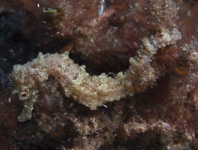Abstract
A new species, Fibularia coffea sp. nov., occurs from shallow waters in Japan. This new species is distinguished from the other species of Fibularia by the following characters: test height is low, oral surface is slightly depressed toward the peristome, number of pores of petal III continues to increase with the test growth, reaching over 30 at TL > 7.5 mm, and black pigments form symmetric pentaradial on aboral surface in living animals. Two further Japanese species, Fibularia japonica and F. ovulum, are redescribed based on the type specimens (F. japonica) and additional specimens (F. ovulum), respectively. A tabular key to the extant species of Fibularia is also provided. A partial fragment of the mitochondrial gene cytochrome oxidase subunit I (COI) of the type specimens of F. coffea sp. nov. and the additional specimen of F. japonica was sequenced for barcoding in future works.
References
Agassiz, L. & Desor, E. (1847) Catalogue raisonné des espèces, des genres, et des familles d’échinides. Annales des Sciences Naturelles, Troisième Série, Zoologie, 7, 129–168.
Clark, A.M. & Rowe, F.W.E. (1971) Monograph of shallow-water Indo-west Pacific Echinoderms. Trustees of the British Museum (Natural History), London, 238 pp.
Clark, H.L. (1909) Scientific results of the trawling expedition of H.M.C.S. “Thetis,” off the coast of New South Wales, in February and March, 1898, Echinodermata. Australian Museum Memoir, 4, 519–564.
https://doi.org/10.3853/j.0067-1967.4.1909.1507
Clark, H.L. (1914) Hawaiian and other Pacific Echini. The Clypeasteridae, Arachnoididae, Laganidae, Fibulariidae, and Scutellidae. Memoirs of the Museum of Comparative Zoology, 46, 1–80.
Clark, H.L. (1928) The sea-lilies, sea-stars, brittle stars and sea-urchins of the South Australian Museum. Records of The South Australian Museum, 3, 361–482.
de Meijere, J.C.H. (1904) Die Echinoidea der Siboga-Expedition. Siboga Expeditie, 43, 1–252.
Gomez, C. & Mooi, R. (2015) New fossil and extant species of Fibularia illuminate evolution of the most highly miniaturized “sand dollars”. Integrative and Comparative Biology, 55, 264. [E264]
Hoareau, T.B. & Boissin, E. (2010) Design of phylum-specific hybrid primers for DNA barcoding: addressing the need for efficient COI amplification in the Echinodermata. Molecular Ecology Resources, 10, 960–967.
https://doi.org/10.1111/j.1755-0998.2010.02848.x
Lamarck, J.-B. (1816) Histoire Naturelle des Animaux sans Vertèbres, présentant les caractères géneraux et particuliers de ces animaux, leur distribution, leur classes, leurs familles, leurs generes, et le citation des principales espèces qui s’y rapportent; précédée d’une Introduction offrant la Détermination des caractères essentiells de l’animal, sa distinction du végétal et des autres corps naturels, enfin, l’Exposition des Principes fondamentaux de la Zoologie. Tome Troisième. Verdière, Paris, 586 pp.
Liao, Y. & Clark, A.M. (1995) The Echinoderms of Southern China. Science Press, New York, 614 pp.
Lovén, S. (1874) Études sur les Échinoïdées. Kongliga Svenska Vetenskaps-Akademiens Handlingar, 11, 1–91.
https://doi.org/10.5962/bhl.title.39607
Mooi, R. (1989) Living and fossil genera of the Clypeasteroida (Echinoidea, Echinodermata): an illustrated key and annotated checklist. Smithsonian Contributions to Zoology, 448, 1–51.
https://doi.org/10.5479/si.00810282.488
Mooi, R. (1990) Paedomorphosis, Aristotle’s lantern, and the origin of the sand dollars (Echinodermata: Clypeasteroida). Paleobiology, 16 (1), 25–48.
https://doi.org/10.1017/S0094837300009714
Mooi, R., Kroh, A. & Srivastava, D.K. (2014) Phylogenetic re-evaluation of fossil and extant micro-echinoids with revision of Tridium, Cyamidia, and Lenicyamidia (Echinoidea: Clypeasteroida). Zootaxa, 3857 (4), 501–526.
https://doi.org/10.11646/zootaxa.3857.4.3Mortensen, T. (1948) A Monograph of the Echinoidea. Vol. 3. Clypeastroida. Clypeastridae, Arachnoididae, Fibulariidae, Laganidae and Scutellidae. C. A. Reitzel, Copenhagen, 471 pp.
Rasband W.S. (1997–2016) ImageJ, U.S. National Institutes of Health, Bethesda, Maryland, USA. Available from: http://imagej.nih.gov/ij (accessed 5 August 2016)
R Core Team (2016) R: A language and environment for statistical computing. R Foundation for Statistical Computing, Vienna, Austria. Available from: https://www.R-project.org/ (accessed 6 November 2018)
Schultz, H. (2005) Sea-Urchins, a Guide to Worldwide Shallow Water Species. Heinke & Peter Schultz Partner Scientific Publication, Hemdingen, 484 pp.
Schultz, H. (2009) Sea-Urchins II, Worldwide Irregular Deep Water Species. Heinke & Peter Schultz Partner Scientific Publication, Hemdingen, 365 pp.
Shigei, M. (1981) A study on the echinoid fauna of the East China Sea and the coastal waters of southern Korea, Kyushu, Ryukyu, and Taiwan. Publications of the Seto Marine Biological Laboratory, 26, 191–241.
https://doi.org/10.5134/176013
Shigei, M. (1982) A new species of the fibulariid sea-urchin, Fibularia japonica, from Japanese waters. Publications of the Seto Marine Biological Laboratory, 27, 11–16.
https://doi.org/10.5134/176047
Shigei, M. (1986) The Sea Urchins of Sagami Bay. Maruzen, Tokyo, 173 pp.
Shigei, M. (2006) A systematical study on the echinoids (Echinodermata, Echinoidea) from the Sagami Sea. Memoirs of the National Science Museum, 41, 305–327.
Warton D.I., Duursma R.A., Falster D.S. & Taskinen S. (2012) smatr 3: an R package for estimation and inference about allometric lines. Methods Ecology and Evolution, 3, 257–259.
https://doi.org/10.1111/j.2041-210X.2011.00153.x
Yoshigou, H. (2009) The Fibulariidae (Echinoidea: Clypeasteroida) collected from sea sand of factory materials (In Japanese). Hibakagaku, 231, 33–40.
Zachos, L.G. (2015) Holistic morphometric analysis of growth of the sand dollar Echinarachnius parma (Echinodermata: Echinoidea: Clypeasteroida). Zootaxa, 4052 (2), 151–179.
https://doi.org/10.11646/zootaxa.4052.2.1

